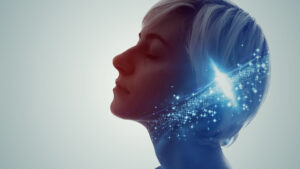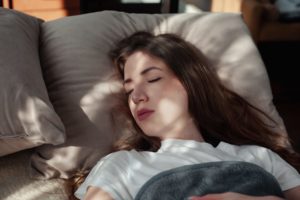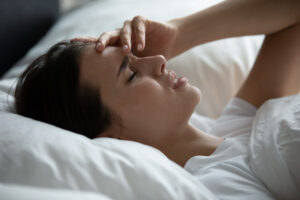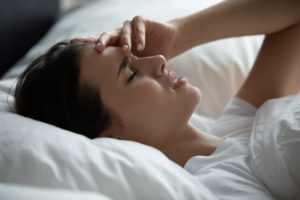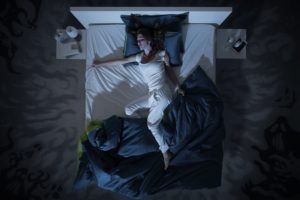Lucid Dream Masks: Do They Work?
In a lucid dream, you are aware that you are dreaming and may even be able to control different aspects of your dream. Lucid dreaming occurs during rapid eye movement (REM) sleep, the stage of sleep in which much of your dreaming occurs. Around 20% of people experience lucid dreaming once a month, and a small number of people manage to have lucid dreams several times a week. Up to half of people never experience a lucid dream.
Some researchers propose lucid dreaming as a tool that can improve your well-being, boost self-confidence and creativity, and help you achieve goals and solve problems in your waking life — although the evidence for these benefits is debatable . Early research suggests lucid dreaming may also have therapeutic potential for people who experience nightmares due to post-traumatic stress disorder (PTSD).
For many people, lucid dreaming is a pleasant experience they would like to have more often. However, since dreams take place while you are asleep, it takes practice and effort to do so. Enter lucid dream masks, a new tool that may make the process easier.
What Are Lucid Dream Masks?
Most lucid dream masks look similar to a traditional sleep mask. They are made from soft materials that should feel comfortable on your face while you sleep. Where they differ is their technology. Lucid dream masks include built-in sensors that monitor your sleep stages and features that gently alert you when you reach REM sleep, helping you become aware of the opportunity to begin lucid dreaming without fully waking you up .
How Do Lucid Dream Masks Work?
Lucid dream masks use timers or movement sensors to estimate when the dreamer is in REM sleep. Then, depending on their specific feature set, lucid dream masks alert the dreamer using audio, visual, or tactile cues:
- Audio Cues: Audio cues may include sounds, or voice messages recorded by the dreamer themselves.
- Tactile Cues: This type of cue may include a pattern of vibrations. This is sometimes called a haptic stimulus.
- Visual Cues: These cues often include a series of flashing lights, delivered via LED lights built into the mask.
These signals are meant to be stimulating enough to partially alert the dreamer, without being so disruptive as to rouse them from sleep. Since the person is dreaming, the cue may become a part of the dream environment. For example, the visual cues may show up as lights in the dream, or the audio signals may sound like a phone ringing.
Most lucid dream masks allow you to adjust the intensity of the dream cues, either directly on the device with an adjustable switch or digitally via an app or website. Whether the mask emits audio, tactile, or visual cues, it is up to the dreamer to recognize the signals and understand that they are experiencing a dream.
How Do Lucid Dream Masks Know You Are in REM Sleep?
The simplest lucid dream masks use a timer to estimate when you have entered REM sleep. This is roughly 90 to 120 minutes from sleep onset. However, the timing of REM sleep can vary from person to person, depending on their age, substance use, or if they have a sleep disorder. A lucid dream mask that relies solely on a timer could deliver light cues during a non-REM stage of sleep, disturbing the person’s sleep quality instead of helping them lucid dream.
Other lucid dream masks use infrared sensors to identify REM by monitoring changes in your eye movement. During REM sleep, your eyes move rapidly, a key feature of REM that differentiates it from other stages of sleep.
Other lucid dream masks contain EEG electrodes to monitor changes in brainwave activity and an accelerometer to monitor body movements. These types of masks use brainwave and body movement activity to identify REM. Your brain waves speed up during REM, looking much like wakefulness, and your brainstem temporarily paralyzes your body to prevent you from acting out your dreams.

Do Lucid Dream Masks Actually Trigger Lucid Dreams?
Wearing a lucid dream mask does not guarantee you will experience a lucid dream, especially if you are new to lucid dreaming. Even with regular practice, lucid dreams are rare . Once a person has mastered traditional lucid dreaming techniques, a lucid dream mask may increase their likelihood of experiencing one. Lucid dreaming techniques include:
- Reality Checks: During the day, a person repeatedly asks themselves if they are awake. This helps them get in the habit of being able to distinguish whether they are awake or asleep.
- Mnemonic Induction of Lucid Dreams (MILD): Along the same lines, a person also learns to distinguish between dreams and reality when they are sleeping. They may sleep for 5 hours, then wake up and say something like, “Next time I’m dreaming, I will remember I am dreaming,” to encourage lucid dreams during their next stage of REM sleep.
- Wake-up-Back-to-Bed (WBTB): WBTB works hand in hand with MILD. It refers to purposeful sleep interruption in which the person wakes up and goes back to sleep within 30 minutes to 2 hours.
The last two techniques in particular, WBTB and MILD, have been shown to increase the frequency of lucid dreams, even among beginners. A person’s likelihood of experiencing a lucid dream triples after WBTB. After practicing these techniques for 5 weeks, 50% of beginners were able to experience at least one lucid dream.
When used in tandem with these techniques, a lucid dream mask may make a person more likely to experience a lucid dream. One early study had participants wear a lucid dream mask during sleep, which sent light cues when they entered REM sleep. To test against a potential placebo effect, the participants knew the mask was a lucid dream mask, but they did not know that it had been programmed to only send the light cues every other night.
While participants reported lucid dreams on nights the dream mask sent light cues as well as on nights it did not, they were more than twice as likely to have a lucid dream on nights the mask sent cues. They were also significantly more likely to say they noticed the lucid dreaming cues on nights the mask was on, leading researchers to conclude that the light cues were effective in increasing the person’s likelihood of lucid dreaming.
Are There Any Side Effects to Using Lucid Dream Masks?
Researchers have not yet studied lucid dream masks for potentially negative effects. However, it is possible the light and sound cues could reduce sleep quality. Exposure to electric light at night, even for short periods of time and in dim settings, can disrupt a person’s circadian rhythm . Similarly, environmental noise exposure triggers a stress response that can disturb sleep and lead to sleep deprivation the following day.
Researchers warn that regularly inducing lucid dreams has two potential drawbacks. It can blur the lines between fantasy and reality, and it may reduce your sleep quality. Lucid dreamers display increased prefrontal cortical brain activity during sleep. In normal sleep, activity in this brain area is inhibited. If someone partially awakens from REM sleep, they may experience sleep paralysis or sleep-related hallucinations and potentially a negative emotional state.
Ongoing Research on Lucid Dream Masks
Lucid dreaming researchers acknowledge that more research needs to be done on how to induce lucid dreaming, with or without a mask. The current body of research is limited, with many studies being either low-quality or having a small number of participants.
However, lucid dream masks may help make other techniques, such as MILD and WBTB, more effective. Beginners may want to start with these techniques before investing in a lucid dream mask.

Still have questions? Ask our community!
Join our Sleep Care Community — a trusted hub of product specialists, sleep health professionals, and people just like you. Whether you’re searching for the perfect mattress or need expert sleep advice, we’ve got you covered. Get personalized guidance from the experts who know sleep best.
References
10 Sources
-
Baird, B., Castelnovo, A., Gosseries, O., & Tononi, G. (2018). Frequent lucid dreaming associated with increased functional connectivity between frontopolar cortex and temporoparietal association areas. Scientific Reports, 8(1), 17798.
https://pubmed.ncbi.nlm.nih.gov/30542052/ -
Soffer-Dudek, N. (2020). Are lucid dreams good for us? Are we asking the right question? A call for caution in lucid dream research. Frontiers in Neuroscience, 13, 1423.
https://pubmed.ncbi.nlm.nih.gov/32038133/ -
Mota-Rolim, S. A., Pavlou, A., Nascimento, G. C., Fontenele-Araujo, J., & Ribeiro, S. (2019). Portable devices to induce lucid dreams—Are they reliable? Frontiers in Neuroscience, 13, 428.
https://pubmed.ncbi.nlm.nih.gov/31133778/ -
LaBerge, S., & Levitan, L. (1995). Validity established of DreamLight cues for eliciting lucid dreaming. Dreaming, 5(3), 159–168.
https://psycnet.apa.org/getdoi.cfm?doi=10.1037/h0094432 -
Shrivastava, D., Jung, S., Saadat, M., Sirohi, R., & Crewson, K. (2014). How to interpret the results of a sleep study. Journal of Community Hospital Internal Medicine Perspectives, 4(5), 24983.
https://pubmed.ncbi.nlm.nih.gov/25432643/ -
Rémi, J., Pollmächer, T., Spiegelhalder, K., Trenkwalder, C., & Young, P. (2019). Sleep-related disorders in neurology and psychiatry. Deutsches Arzteblatt International, 116(41), 681–688.
https://pubmed.ncbi.nlm.nih.gov/31709972/ -
Schredl, M., Dyck, S., & Kühnel, A. (2020). Inducing lucid dreams: The wake-up-back-to-bed technique in the home setting. Dreaming, 30(4), 287–296.
https://psycnet.apa.org/record/2021-00512-001 -
Aspy, D. J. (2020). Findings from the international lucid dream induction study. Frontiers in Psychology, 11, 1746.
https://pubmed.ncbi.nlm.nih.gov/32765385/ -
Duffy, J. F., & Czeisler, C. A. (2009). Effect of light on human circadian physiology. Sleep Medicine Clinics, 4(2), 165–177.
https://pubmed.ncbi.nlm.nih.gov/20161220/ -
Halperin, D. (2014). Environmental noise and sleep disturbances: A threat to health? Sleep Science, 7(4), 209–212
https://pubmed.ncbi.nlm.nih.gov/26483931/




